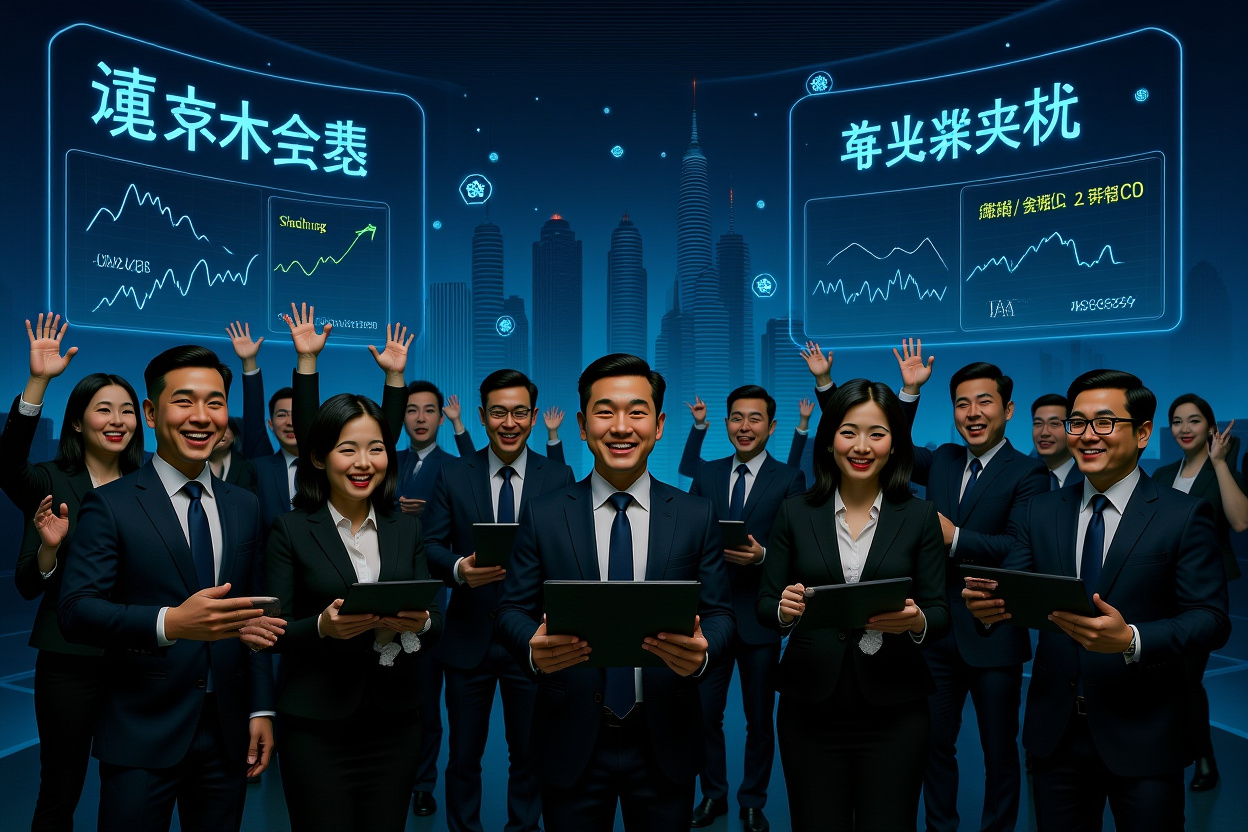Asia-Pacific Equity Markets Scale New Heights
Asian markets opened the week with spectacular gains as semiconductor stocks propelled benchmark indices to record levels. South Korea’s KOSPI and Japan’s Nikkei 225 both surged over 1% in early Monday trading, continuing a remarkable bullish trend across the region. This powerful rally demonstrates the resilience of Asia-Pacific markets despite ongoing global trade uncertainties and shifting monetary policies.
The semiconductor sector emerged as the primary catalyst, with industry giants Samsung Electronics and Renesas Electronics both posting gains exceeding 3%. This sector-wide strength reflects growing confidence in memory chip demand and artificial intelligence infrastructure development. Market participants are closely monitoring how these Asia-Pacific markets hit record highs while navigating complex international trade relationships.
South Korea’s KOSPI Reaches Historic Peak
The Korea Composite Stock Price Index achieved a milestone moment during morning trading, briefly surpassing the 3,481.96 level before settling at a 0.72% gain. This represents the latest in a series of record-breaking performances for South Korea’s benchmark index, highlighting the market’s robust fundamentals despite external headwinds.
Semiconductor Giants Lead the Charge
Samsung Electronics spearheaded the advance with a 4% surge that pushed its market capitalization above 490 trillion won. The rally followed reports that the company’s 12-layer HBM3E memory chips had successfully passed NVIDIA’s qualification tests. This technological breakthrough positions Samsung to capture significant market share in the high-bandwidth memory segment crucial for AI applications.
Analysts from major financial institutions have responded with upgraded assessments. Citi analyst Peter Lee maintained his buy rating with a 110,000 won price target, anticipating formal HBM3E certification by late September or early October. Meanwhile, Morgan Stanley raised its target price from 86,000 to 97,000 won, citing improved memory pricing and competitive positioning.
Export Data Reveals Mixed Signals
South Korea’s trade statistics presented a complex picture for investors. While overall exports declined 10.6% year-over-year for the first 20 days of September, semiconductor exports surged 27%, building on August’s 30% growth. Automotive exports also showed strength with a 15% increase, though petrochemical products struggled due to tariffs and weakening global demand.
The data highlights the critical importance of the semiconductor sector to South Korea’s economic health. As these Asia-Pacific markets hit record highs, investors are weighing strong sector-specific performance against broader trade challenges, including recent U.S. tariff increases that have placed additional pressure on Korean exporters.
U.S.-Korea Trade Negotiations Intensify
The trade relationship between South Korea and the United States remains a focal point for market participants. The two nations reached a preliminary agreement in July that would reduce auto tariffs from 25% to 15% in exchange for Korean investments totaling $350 billion. However, negotiations have stalled due to disagreements over specific terms and conditions.
Financial Stability Concerns Emerge
President Yoon Suk Yeol expressed serious concerns about the potential economic impact of the proposed agreement. He warned that meeting U.S. investment demands without securing a currency swap arrangement could trigger financial instability reminiscent of the 1997 Asian financial crisis. This statement underscores the high-stakes nature of the ongoing negotiations.
Trade Minister Ahn Duk-geun (吕翰九) recently returned from Washington after meetings with U.S. Trade Representative Katherine Tai and congressional leaders. He emphasized that South Korea’s circumstances differ significantly from Japan’s, which accepted less favorable terms in its own trade agreement with the United States. The minister acknowledged the seriousness of auto tariff issues while expressing commitment to reaching a mutually acceptable solution.
Japanese Equities Join the Rally
Japan’s Nikkei 225 index mirrored its Korean counterpart with strong gains approaching 1.3%. The broad-based advance saw particularly impressive performances from semiconductor equipment manufacturers and electronics firms. LASERTEC surged nearly 9%, while Shoko Co. gained approximately 7%. Renesas Electronics, Nintendo, Sony, and Sharp all posted gains exceeding 3%.
Political Transition Creates Uncertainty
The rally occurred against the backdrop of significant political developments as the ruling Liberal Democratic Party began its leadership election process. With approximately 915,600 eligible voters—a decrease of over 140,000 from the previous election—the party will select a new leader on October 4. The outcome could significantly influence Japan’s economic policies and international relationships.
Five candidates have emerged as contenders: former Secretary-General Toshimitsu Motegi (茂木敏充), Chief Cabinet Secretary Yoshimasa Hayashi (林芳正), Agriculture Minister Shinjiro Koizumi (小泉进次郎), former Economic Security Minister Sanae Takaichi (高市早苗), and former Administrative Reform Minister Takuya Hirai (小林鹰之). Their policy debates will likely address pressing issues including inflation control and cross-party cooperation.
Bank of Japan Shifts ETF Strategy
In a significant policy development, the Bank of Japan announced plans to gradually reduce its massive exchange-traded fund holdings. Governor Kazuo Ueda (植田和男) explained that the unprecedented purchasing program had served its purpose during the battle against deflation. With economic conditions improving and market functioning normalizing, maintaining such extensive holdings is no longer necessary.
The central bank will reduce its ETF holdings by approximately 330 billion yen ($2.2 billion) annually. At this pace, completely unwinding the current $251 billion portfolio would take over a century, demonstrating the BOJ’s cautious approach to avoiding market disruption. This measured transition reflects confidence in Japan’s economic recovery while acknowledging ongoing challenges including U.S. trade policies and domestic political uncertainty.
Regional Market Implications and Opportunities
The synchronized strength across Asian markets presents both opportunities and challenges for international investors. The semiconductor sector’s outperformance suggests continued robust demand for advanced memory and processing chips, particularly as artificial intelligence applications expand globally. However, trade tensions and tariff policies create uncertainty that requires careful navigation.
Investment Strategy Considerations
For institutional investors monitoring these Asia-Pacific markets hit record highs, several factors warrant attention. First, the semiconductor supply chain offers compelling growth prospects, though individual company valuations require scrutiny. Second, trade policy developments could create volatility, particularly for export-dependent economies and sectors. Third, currency fluctuations may impact returns for dollar-based investors.
– Focus on companies with proven technological advantages and strong intellectual property portfolios
– Monitor trade negotiation developments for potential market impacts
– Consider currency hedging strategies to manage exchange rate risk
– Evaluate political developments for policy implications
Forward-Looking Market Assessment
The remarkable performance of Asia-Pacific equities reflects underlying economic strength and technological leadership. Semiconductor innovation continues to drive growth while creating spillover benefits across multiple sectors. However, investors must remain attentive to several critical factors that could influence future market direction.
Trade relationships between Asian nations and the United States will likely evolve through upcoming negotiations and policy decisions. Central bank policies are gradually normalizing after years of extraordinary stimulus, creating both challenges and opportunities. Technological advancement continues at a rapid pace, particularly in memory chips and artificial intelligence applications.
As these Asia-Pacific markets hit record highs, sophisticated investors should maintain balanced exposure while preparing for potential volatility. The fundamental strength of leading companies, particularly in technology sectors, provides reason for optimism. However, prudent risk management remains essential given ongoing trade uncertainties and policy transitions.
Market participants should continue monitoring earnings reports from semiconductor manufacturers, trade negotiation developments, and central bank policy statements. These factors will likely determine whether current record levels represent sustainable peaks or temporary highs. For now, the combination of technological innovation and economic recovery continues to support Asian equity markets.




